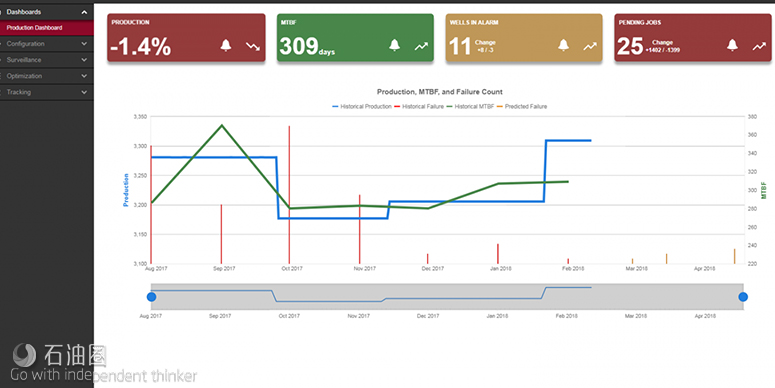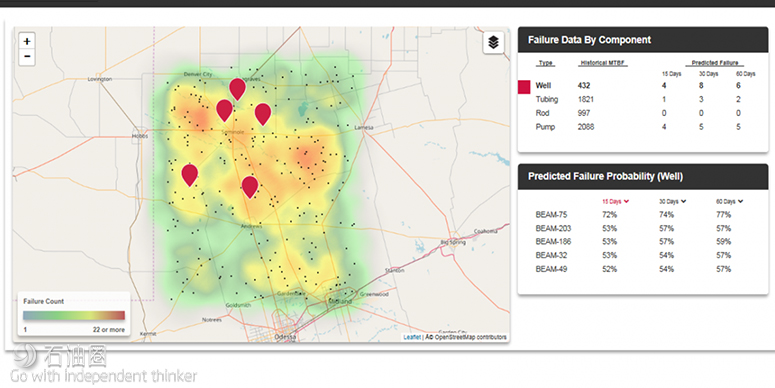As the oil and gas industry adjusts to the “new normal” oil price environment, it faces the challenge of managing a vast array of field assets with limited resources.
This is particularly true in producing fields with hundreds or thousands of wells on some form of artificial lift and with fewer engineers available to oversee them. The number of engineers with decades of experience in rod pumping, for example, is lower than it was five years ago—a loss of expertise that cannot be quickly replaced. Those remaining in the field are stretched thin and cannot effectively manage thousands of wells or make fast, informed changes to each well’s lift system as well conditions change.
Connecting the production ecosystem
The manufacturing sector is in the midst of a transformation that is driven by the Internet of Things, smart sensors, cloud computing and machine learning concepts. This trend toward greater automation and data exchange in manufacturing, a concept commonly referred to as Industry 4.0, delivers vast improvements to efficiency, safety and production optimization.
The oil and gas industry already has started adopting Industry 4.0 concepts to leverage its resources more effectively in various parts of the value chain. Working from this foundation, Weatherford created a technology and business vision for a Production 4.0 ecosystem. The ForeSite production optimization software platform was developed specifically to help the industry use these concepts to lift field production to new levels of efficiency. Combining physics-based models and historical trending with machine learning data analytics, the platform helps operators improve performance across diverse oil and gas asset types, including unconventional, conventional, onshore and offshore.
The ForeSite platform uses physics-based models and advanced analytics to analyze data from every corner of the asset, enhancing decision-making.
The ForeSite platform was introduced in 2017 with the aim of providing the industry’s first system combining optimization support and predictive analytics for reciprocating rod lift systems. The platform has recently been expanded to provide support for gas lift, electric submersible pump (ESP) systems and naturally flowing wells—all from a single platform.
The extensive range of engineering calculations and modeling engines has fine-tuned performance in more than 150,000 wells around the world over the past 15 years.
The ForeSite platform combines these technologies with Industry 4.0 principles to deliver methods of optimizing the performance of each asset. By harnessing data across the production ecosystem from the reservoir to surface facilities, operators can make more informed decisions that maximize production rates at a lower cost per barrel.
Optimizing assets from afar
By providing real-time access to production data and the ability to analyze it at a granular level, the platform helps operators make smarter optimization decisions for an ever-growing range of artificial lift types. The platform affords live asset production tracking from an intuitive, visual interface and real-time diagnostics that identify any atypical behavior in a well’s performance. For example, the platform can compare rod lift dynamometer characteristics with an extensive card library to help operators diagnose factors affecting well performance.
When it detects changes in production trends or operating parameters deviating outside of set points, the platform sends intelligent alarms to the user’s desktop or mobile device. Additionally, because all ForeSite software integrates with Weatherford’s CygNet SCADA platform, operators have the option of creating a closed-loop, end-to-end optimization cycle. For example, if the data analysis suggests that a field parameter (e.g., the position of a choke, a compressor setting or the speed of a pump) needs to be changed to improve well performance, the SCADA engine allows the command to be securely sent and applied remotely.
Because artificial lift requirements often change over time, the platform is designed to help operators select the right form of lift for each stage in the life of the well. Using both current and projected data, including inflow and completion modeling, fluid properties, pressure- volume-temperature analysis and flow dynamics, the platform anticipates problems and offers insights that ease the transition to alternate lift methods as reservoir conditions change.
Reducing failure frequency
To help ensure asset optimization and reliability on a longer time horizon, the platform’s predictive analytics proactively identify minor performance issues before they develop into bigger, more expensive problems. This feature combines field data with advanced analytics tools to gauge the performance of each asset.
Using equipment failure history as a guide, the platform applies artificial intelligence to predict subsurface failure by lift component. By routinely tracking equipment performance at the individual component level, operators are able to extend the mean time between failures through proactive corrective measures. Operational settings can be tweaked to extend equipment runlife, and workover rigs and maintenance crews can be dispatched ahead of time to reduce downtime and associated production losses.
Failure prediction and early-warning capabilities enable management by exception.
When well intervention becomes necessary, the platform’s Field Services Management module enables users across different areas of the operation, including third-party rig crews, engineers, production planners and management, to collaborate on workover plans. The module includes an application for economic analysis, enabling engineers to evaluate all jobs in the queue and prioritize the rig schedule based on which activities will bring the highest return on investment. It also visualizes historical data in a way that helps users analyze operational issues, understand cost drivers and determine best operating practices.
The platform’s failure prediction and early warning capabilities give operators the tools to manage their assets by exception. This lets already-stretched field operations and work crews devote more time to optimizing performance rather than looking for problems. Embedding predictive failure analysis into the production workflow is a key advantage, enabling users to perform physics-based analysis and advanced analytics on the same platform.
Future developments
In addition to the platform’s current capabilities, further developments are underway to expand its applications. One ongoing project involves predictive analytics for failure management of ESPs, which deliver high production rates but are expensive to repair. Advanced analytical models for ESPs aim to minimize downtime that costs an operator in terms of both high workover rates and deferred production.
The platform’s modeling and predictive analytics capabilities continue transitioning to the cloud, which eases installation and minimizes maintenance issues. This is a particular benefit for smaller E&P companies that are emerging from the downturn with limited in-house IT infrastructure and a deficit of the field expertise required to optimize performance. These companies want the optimization capabilities that the software platform provides, but they do not have the manpower or IT budget to manage it themselves.
Through a cloud-based solution, companies can access the platform from a secure, Weatherford-hosted website. They can then analyze all production and artificial lift system data from the site to make their own decisions aimed at improving performance at each well or across the field. For operators requiring both the software and engineering consultation, Weatherford’s team of production advisers review the data with them and provide insights and recommendations that inform a deeper understanding of each asset and help ensure that the best optimization decisions are made.
As the oil and gas industry emerges from the downturn, it enters a new era of automation and digitalization. Technologies such as the ForeSite platform can help operators harness their field data for vastly improved analysis, predictability and long-term production at a significantly lower operating expense.

 石油圈
石油圈


